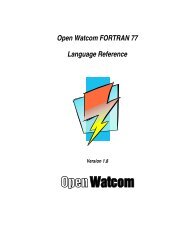Relocatable Object Module Format (OMF) Specification
Relocatable Object Module Format (OMF) Specification
Relocatable Object Module Format (OMF) Specification
Create successful ePaper yourself
Turn your PDF publications into a flip-book with our unique Google optimized e-Paper software.
<strong>Relocatable</strong> <strong>Object</strong> <strong>Module</strong> <strong>Format</strong><br />
Example<br />
The following LEDATA record contains a simple text string:<br />
0 1 2 3 4 5 6 7 8 9 A B C D E F<br />
0000 A0 13 00 02 00 00 48 65 6C 6C 6F 2C 20 77 6F 72 ...... Hello, wor<br />
0010 6C 64 0D 0A 24 A8 ld..$.<br />
Byte 00H contains 0A0H, which identifies this as an LEDATA record.<br />
Bytes 01-02H contain 0013H, the length of the remainder of the record.<br />
Byte 03H (the Segment Index field) contains 02H, a reference to the second SEGDEF record in the object module.<br />
Bytes 04-05H (the Enumerated Data Offset field) contain 0000H. This is the offset, from the base of the segment<br />
indicated by the Segment Index field, at which the data in the Data Bytes field will be placed when the program is<br />
linked. Of course, this offset is subject to relocation by the linker because the segment declared in the specified<br />
SEGDEF record may be relocatable and may be combined with other segments declared in other object modules.<br />
Bytes 06-14H (the Data Bytes field) contain the actual data.<br />
Byte 15H contains the Checksum field, 0A8H.<br />
48 <strong>OMF</strong> <strong>Specification</strong>, Version 1.1 Tool Interface Standards (TIS)
















